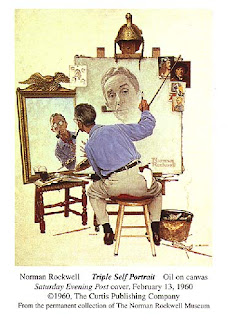My friends and I went to Dayton to their Art Institute to see American Chronicles: The Art of Norman Rockwell. The paintings coming from the Norman Rockwell Museum in Stockbridge, Mass. The exhibit traces the evolution of Rockwell's art and illustrations throughout his career. The exhibit has 42 original artworks and a complete set of 323 Saturday Evening Post cover tear sheets spanning 47 years.
Norman Rockwell began his career as a teenager. His first publications was Tell Me Why. At nineteen he became the art editor of Boy's Life magazine, the official magazine of the Boys Scouts of America. He began his career at the Saturday Evening Post in 1916. Rockwell drew and painted over four thousand images in which he explored the impact on popular culture with his reflections on childhood innocence to powerful, consciousness-raising images.
In this exhibit we saw these powerful illustrations in his Four Freedoms (Freedom of Speech; Freedom of Want; Freedom of Fear; Freedom of Religion), A Scout is Helpful, the painting of Murder In Mississippi along with the sketches and news clippings about the tragedy, The Problem We All Live With about Civil Rights and the Supreme Courts ordering of integration in schools. Idyllic childhood images such as Going and Coming, A Day in The Life of a Young Girl, No Swimming and Girl at Mirror. Whether the images were comical, idyllic or powerful they were all amazingly painted.
One of my favorites was The Critique. The young man inspecting the Dutch influenced painting was Norman Rockwell's son. In his preparation of this painting, Norman Rockwell did many, many sketches of the paintings in this illustration. He painted the paintings in this illustration in the classical style of Peter Paul Rubens (portrait of his wife) and the Dutch cavaliers in the painting watching the young man's inspection of the lady.
In Rockwell's preparation he used several models to pose and take shots of their expressions from different angles. He then did a full sized study of the scene in pencil or charcoal. The woman's face was painted on clear plastic in many ways. Rockwell then held these sketches to the canvas until he found the head shot and expression that he liked. When he liked his sketches, Rockwell painted color studies. When all the preliminary work was finished, the final oil painting was started.
As the student leans in to look closer at the woman, she gives him a comical, yet quizzical look as if to say "get back buster!" The gentlemen's animated expressions, in the background painting, look on with concern as the boy leans into the painting. They probably wonder if the young man is getting too close to the lady. I just love the humor in this painting. The Critique was on the cover of the Saturday Evening Post April 1955.
Norman Rockwell is considered an illustrator, but I have always admired him as an artist.
I am lucky that I have friends that enjoy seeing exhibits and travel with me to view them. This exhibit will be at the Dayton Art Institute until February 5, 2012. I highly recommend the trip to see this thought provoking body of work.
Gaylynn
 |
| Norman Rockwell Four Freedoms: Freedom of Religion |
In this exhibit we saw these powerful illustrations in his Four Freedoms (Freedom of Speech; Freedom of Want; Freedom of Fear; Freedom of Religion), A Scout is Helpful, the painting of Murder In Mississippi along with the sketches and news clippings about the tragedy, The Problem We All Live With about Civil Rights and the Supreme Courts ordering of integration in schools. Idyllic childhood images such as Going and Coming, A Day in The Life of a Young Girl, No Swimming and Girl at Mirror. Whether the images were comical, idyllic or powerful they were all amazingly painted.
 |
| Norman Rockwell TheCritique |
In Rockwell's preparation he used several models to pose and take shots of their expressions from different angles. He then did a full sized study of the scene in pencil or charcoal. The woman's face was painted on clear plastic in many ways. Rockwell then held these sketches to the canvas until he found the head shot and expression that he liked. When he liked his sketches, Rockwell painted color studies. When all the preliminary work was finished, the final oil painting was started.
As the student leans in to look closer at the woman, she gives him a comical, yet quizzical look as if to say "get back buster!" The gentlemen's animated expressions, in the background painting, look on with concern as the boy leans into the painting. They probably wonder if the young man is getting too close to the lady. I just love the humor in this painting. The Critique was on the cover of the Saturday Evening Post April 1955.
Norman Rockwell is considered an illustrator, but I have always admired him as an artist.
I am lucky that I have friends that enjoy seeing exhibits and travel with me to view them. This exhibit will be at the Dayton Art Institute until February 5, 2012. I highly recommend the trip to see this thought provoking body of work.
Gaylynn

Comments
Deb,I love going up to DAI. They always have interesting exhibits. I am not on the mailing list, but I check every January and August for the years shows at DAI and Columbus. Both do a fabulous job of bringing excellent exhibits to their establishment. Having said that I am excited for the small exhibit that the CAM is opening next month on Monet.